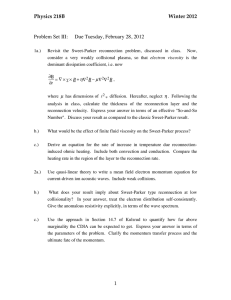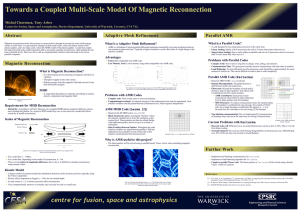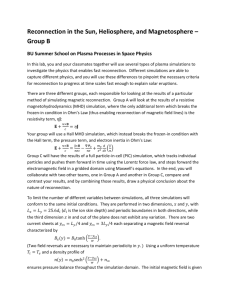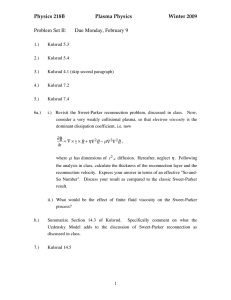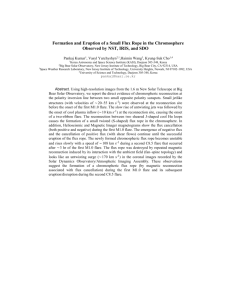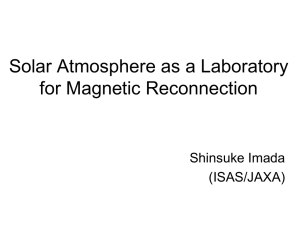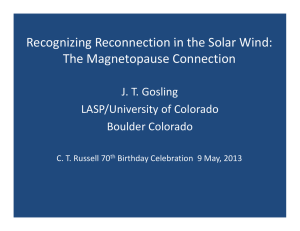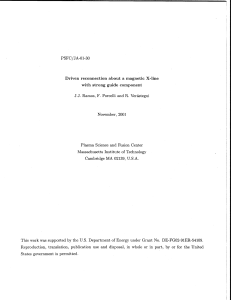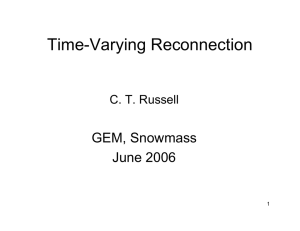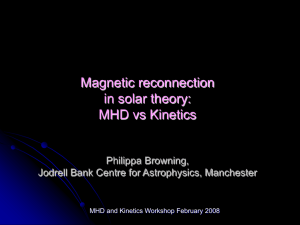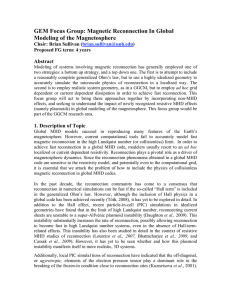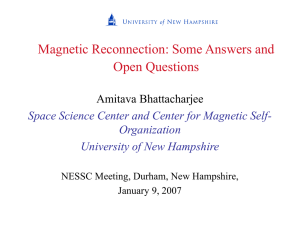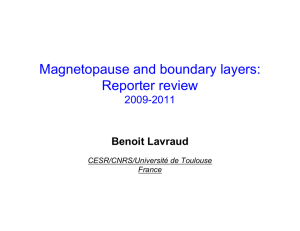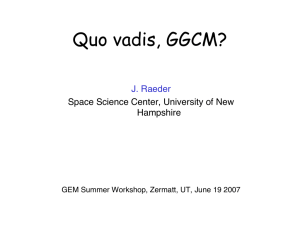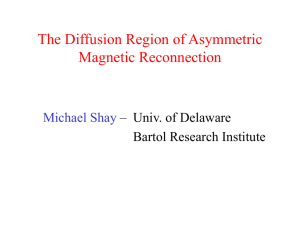A FORMULATION FOR THE RESISTIVE WALL BOUNDARY
advertisement
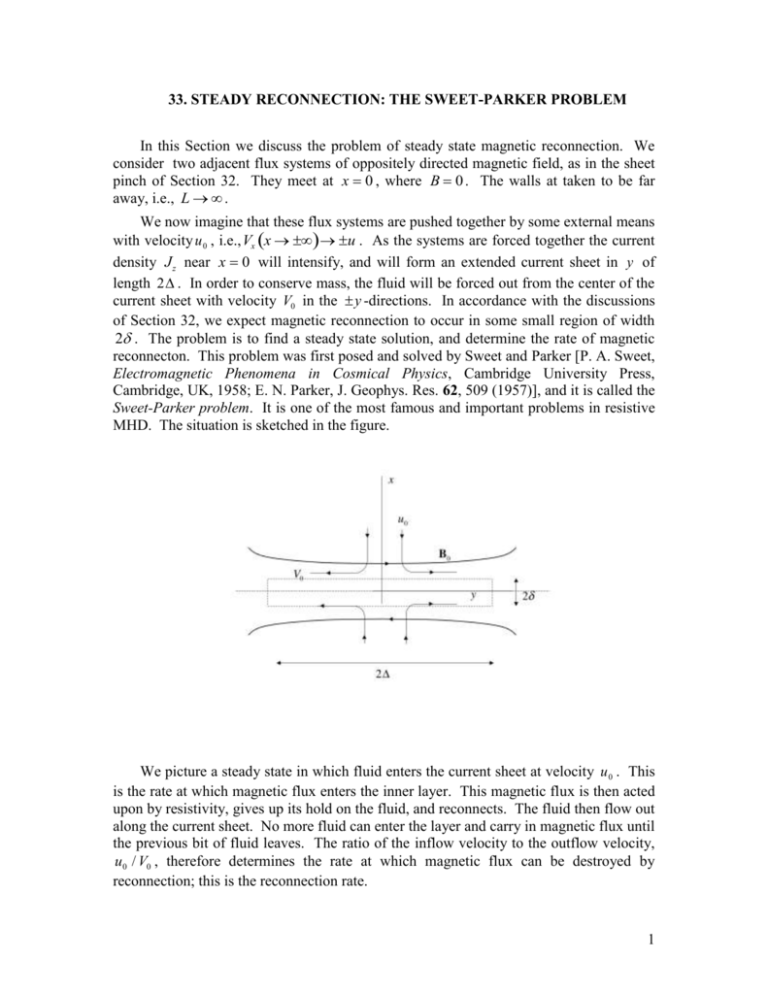
33. STEADY RECONNECTION: THE SWEET-PARKER PROBLEM In this Section we discuss the problem of steady state magnetic reconnection. We consider two adjacent flux systems of oppositely directed magnetic field, as in the sheet pinch of Section 32. They meet at x 0 , where B 0 . The walls at taken to be far away, i.e., L . We now imagine that these flux systems are pushed together by some external means with velocity u 0 , i.e., Vx x u . As the systems are forced together the current density J z near x 0 will intensify, and will form an extended current sheet in y of length 2 . In order to conserve mass, the fluid will be forced out from the center of the current sheet with velocity V0 in the y -directions. In accordance with the discussions of Section 32, we expect magnetic reconnection to occur in some small region of width 2 . The problem is to find a steady state solution, and determine the rate of magnetic reconnecton. This problem was first posed and solved by Sweet and Parker [P. A. Sweet, Electromagnetic Phenomena in Cosmical Physics, Cambridge University Press, Cambridge, UK, 1958; E. N. Parker, J. Geophys. Res. 62, 509 (1957)], and it is called the Sweet-Parker problem. It is one of the most famous and important problems in resistive MHD. The situation is sketched in the figure. We picture a steady state in which fluid enters the current sheet at velocity u 0 . This is the rate at which magnetic flux enters the inner layer. This magnetic flux is then acted upon by resistivity, gives up its hold on the fluid, and reconnects. The fluid then flow out along the current sheet. No more fluid can enter the layer and carry in magnetic flux until the previous bit of fluid leaves. The ratio of the inflow velocity to the outflow velocity, u0 / V0 , therefore determines the rate at which magnetic flux can be destroyed by reconnection; this is the reconnection rate. 1 If we assume incompressibility, then the mass coming into the inner layer must equal the mass exiting the inner layer. Since V 0 , u0 L V0 . (33.1) Away from the inner layer, the flow and field are governed by ideal MHD, so Ez u0 B0 . (33.2) Within the inner layer, resistivity dominates, so Ez J z B0 . 0 (33.3) In steady state, Ez ~ constant , so equating (33.2) and (33.3), u0 . 0 (33.5) We have seen that we can ignore inertial away from the inner layer, so that in the outer region the x-component of force balance is B2 p 0 . x 2 0 (33.6) Integrating this outward from the current sheet (from x 0 to ), we have p B2 pmax , 2 0 (33.7) where p and B are the pressure and magnetic fields far from the current sheet, and pmax is the pressure at the center of the current sheet; we identify p and B with p0 and B0 , the upstream pressure and field. Then 1 2 B0 pmax p0 . 2 (33.8) Force balance along the sheet, in the y-direction, is V V p , or 1 2 p . Vy y 2 y (33.9) Integrating from 0 to , we have 1 2 V0 pmax p0 . 2 (33.10) Equating Equations (33.8) and (33.9), we find V0 B0 0 VA0 . (33.11) The downstream (outflow) velocity is therefore equal to the upstream Alfvén velocity. This is a limit to how fast the fluid can get out of the layer so that more reconnection can 2 occur. It is set by the upstream conditions, far from the current sheet. It acts as a throttle on the reconnection rate. Equations (33.1), (33.5), and (33.11) are three equations in the five unknowns u 0 , V0 , , , and . We can determine u 0 and in terms of V0 , , and . One result is / 0 S , 0 VA 2 (33.12) or S01/ 2 , (33.13) where S0 is the Lundquist number based in the upstream magnetic field and the length of the current layer. Generally S0 1 , so that the current layer becomes very long and thin. The other result is u0 u 0 M 0 S01/2 , V0 VA0 (33.14) where M 0 is the upstream Alfvén Mach number. Therefore, the steady state reconnection rate scales like S01/2 1 . This is called the Sweet-Parker rate. It is one of the most famous results in MHD. If you push harder from the outside, so that u 0 increases, then for a given S0 , M 0 constant , so that V0 VA0 must also increase to maintain the same ratio. This occurs by compressing the field and increasing B0 ; the rate of reconnection remains constant, and is set by the resistivity. Pushing harder at fixed S0 just compresses the magnetic field, it does not increase the reconnection rate. Unfortunately, for S ~ 1010 , M 0 ~ 105 is not large enough to account for the inferred reconnection rate associated with solar flares, coronal mass ejections, tokamak sawtooth crashes, and other experiments. To date, nobody has found a way within the resistive MHD model to make the reconnection rate scale faster than S 1/2 ; one is stuck with Sweet-Parker. Over the past several years, there has been considerable research that indicates that so-called “fast reconnection” (i.e., faster than Sweet-Parker) can occur if effects outside of resistive MHD are accounted for in Ohm’s law. This is not surprising in light of Equation (33.13); at large S the width of the reconnection layer can become small enough that the fundamental MHD assumptions break down, and other physics may dominates the reconnection process. However, theories based on these equations are quite complicated, and are difficult to analyze and solves in more general geometry. Today, one still relies primarily on resistive MHD to study the global dynamics, with appeals to artificially enhanced “anomalous” resistivity to obtain sufficient rates of reconnection. 3


